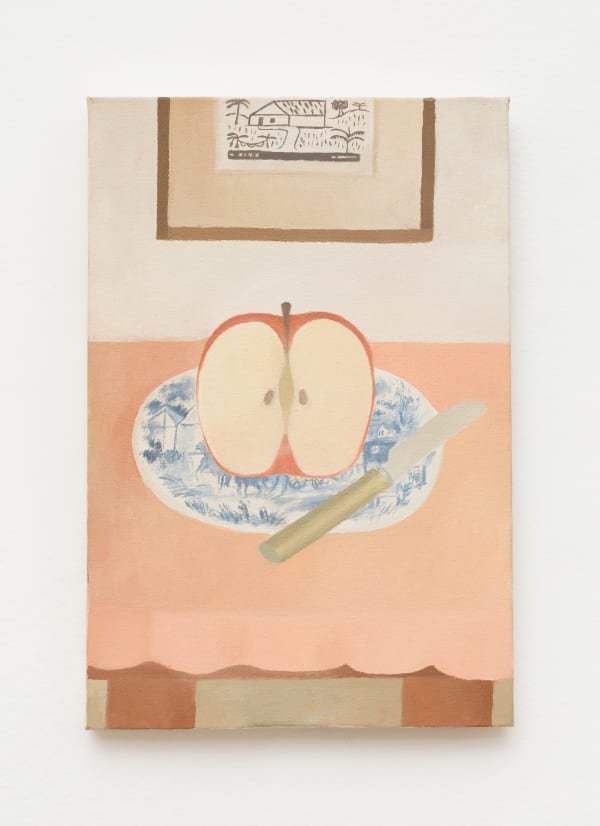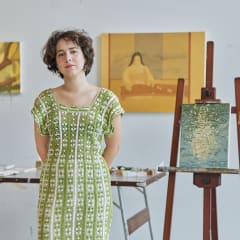Arrebalde Paula Siebra
Past exhibition
Overview
Paula Siebra has only recently begun exhibiting her work and this is her first exhibition in São Paulo. As a young artist based in Fortaleza (Ceará), she is still defining her areas of interest. Even though she paints contemporary subjects, her practice evokes the best of 20th-century Latin American painting. We find landscapes featuring decorative arrangements that remind us of artists such as Neves Torres and Lorenzato; portraits of focused women, such as those painted by Diego Rivera, Djanira, and Di Cavalcanti; as well as the coastal imagery of Alfredo Volpi, Oswaldo Goeldi, and José Pancetti.
However, her work does not offer a romantic idealization of the rural world, nor the utopian impulse of 20th century avant-gardes. Her paintings depict scenarios that are absolutely ordinary; they are not a counterpoint to the present. These are domestic everyday items, decorative objects that we find in coastal street markets – bottles filled with colored sand, ceramic bowls, iron jars holding flowers.
Everything seems worn out. Siebra’s affective memory is inhabited by obsolete, residual even, vestiges of a mercantile world. They are small-scale pieces delicately painted with soft brushstrokes, short on paint. Her colors are somewhat subdued, simultaneously sparse and bright. They shine whilst curtailing contrast. We are left unsure if the orange tone is light or dust.
Paula Siebra’s works resist the journalistic euphoria of tackling the agony of the present. They are absurdly calm. The relationship between the painting and our times is indirect. Their contemplative attitude is an attempt to make permanent the aspects of life that are eroded from our memory, buried by noise, by the demands of the world of work, by the blinding light of a hot summer afternoon. They depict those images that are barely grasped by our gaze when we close our eyes against sizzling sunrays scorching our eyelids.
–Lucas Arruda and Tiago Mesquita
However, her work does not offer a romantic idealization of the rural world, nor the utopian impulse of 20th century avant-gardes. Her paintings depict scenarios that are absolutely ordinary; they are not a counterpoint to the present. These are domestic everyday items, decorative objects that we find in coastal street markets – bottles filled with colored sand, ceramic bowls, iron jars holding flowers.
Everything seems worn out. Siebra’s affective memory is inhabited by obsolete, residual even, vestiges of a mercantile world. They are small-scale pieces delicately painted with soft brushstrokes, short on paint. Her colors are somewhat subdued, simultaneously sparse and bright. They shine whilst curtailing contrast. We are left unsure if the orange tone is light or dust.
Paula Siebra’s works resist the journalistic euphoria of tackling the agony of the present. They are absurdly calm. The relationship between the painting and our times is indirect. Their contemplative attitude is an attempt to make permanent the aspects of life that are eroded from our memory, buried by noise, by the demands of the world of work, by the blinding light of a hot summer afternoon. They depict those images that are barely grasped by our gaze when we close our eyes against sizzling sunrays scorching our eyelids.
–Lucas Arruda and Tiago Mesquita
Works
-
 Paula Siebra, Jasmineiro à noite, 2017
Paula Siebra, Jasmineiro à noite, 2017 -
 Paula Siebra, Mesa de cabeceira, 2019
Paula Siebra, Mesa de cabeceira, 2019 -
 Paula Siebra, Lírios, 2019
Paula Siebra, Lírios, 2019 -
 Paula Siebra, Jarrinha com flores, 2019
Paula Siebra, Jarrinha com flores, 2019 -
 Paula Siebra, Vaso de flores, 2020
Paula Siebra, Vaso de flores, 2020 -
 Paula Siebra, Igrejinha dourada, 2020
Paula Siebra, Igrejinha dourada, 2020 -
 Paula Siebra, Natureza-morta com louças de barro e prato de ágata, 2020
Paula Siebra, Natureza-morta com louças de barro e prato de ágata, 2020 -
 Paula Siebra, Vista da janela, 2019
Paula Siebra, Vista da janela, 2019 -
 Paula Siebra, Varal, 2020
Paula Siebra, Varal, 2020 -
 Paula Siebra, Gelágua, 2020
Paula Siebra, Gelágua, 2020 -
 Paula Siebra, Natureza-morta com louça inglesa e maçã, 2019
Paula Siebra, Natureza-morta com louça inglesa e maçã, 2019 -
 Paula Siebra, Igrejinha, 2019
Paula Siebra, Igrejinha, 2019 -
 Paula Siebra, Duas tulipas, 2020
Paula Siebra, Duas tulipas, 2020 -
 Paula Siebra, Arrebol, 2020
Paula Siebra, Arrebol, 2020 -
 Paula Siebra, Vaso de flores, 2020
Paula Siebra, Vaso de flores, 2020 -
 Paula Siebra, Mulher entediada, 2019
Paula Siebra, Mulher entediada, 2019
Installation Views

















